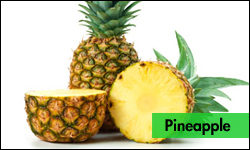Back to > Major Fruits | Minor Fruits | Underutilized Fruits
![]()
 |
||
|
|
||
Name and Botany:
Pineapple belongs to the order Bromeliales, family Bromeliaceae, sub-family Bromelioideae. The Bromeliaceae have adapted to a very wide range of habitats. The Bromeliaceae are divided into three subfamilies, the Pitcarnioideae, the Tillandsioideae and the Bromelioideae. They are monocots but different from other monocots by several unique characters.
Pineapple is the most important economic plant in the Bromeliaceae. From the first observation of the pineapple by European explorers to the present time, pineapple taxonomy has varied considerably. The first botanical description of cultivated pineapple was by Charles Plumier at the end of the 17th century when he created the genus Bromelia for the plants called karatas, in honour of the Swedish physician Olaf Bromel and also described Ananas as Ananas aculeatus fructu ovato, carne albida. Linnaeus in 1753 in his Species Plantarum designated the pineapple as Bromelia ananas and Bromelia comosa.
The present classification is as follows:
¨ Ananas comosus var. ananassoides (formerly two species: A. ananassoides and A. nanus);
¨ Ananas comosus var. bracteatus (formerly two species: A. bracteatus and A. fritzmuelleri)
¨ Ananas comosus var. comosus (formerly A. comosus)
¨ Ananas comosus var. erectifolius (formerly A. lucidus.(formerly A. erectifolius))
¨ Ananas comosus var. parguazensis (formerly A. parguazensis)
¨ Ananas macrodontes (formerly Pseudananas sagenarius)
Common Names:
| pineapple | English |
| Ananas, Pain ade Sucre | French |
| Ananas | German |
| Abacaxi, ananás, abacaxí-do-mato, ananás-selvagem, gravatá | Portuguese (Brazil)] |
| ananá, piña, piña de América, piña tropical | Spanish |
| Nanas, Danas, Naneh | Indonesian |
| Nanas, Nanas Pager | Malaysian |
| Apangdan (Bantok) | Philippines |
| Sapparot | Thai |
| Dua, Thom | Vietnamese |
| Huangli | Mandarin |
| Annaci palam | Tamil |
| Mahk nut | Laotian |
| Manoa | Khmer |
| Narnuthi | Burmese |
Botanical description
Domesticated pineapple (Ananas comosus (L.) Merrill is now botanically named as Ananas comosus var comosus). It is one of the most commercially important fruit crops which carry out Crassulacean acid metabolism, orCAM photosynthesis. It is grown mainly for fresh and canned fruit and juice and is the only source of bromelain, an enzyme used in pharmaceuticals and as meat-tenderising agent. Pineapple is not known to be allergenic but can be toxic to workers who cut pineapples. When unripe, pineapple is inedible and poisonous, and can irritate the throat, causes burning sensation on lips and mouth and act as a drastic purgative.
Plant: Pineapple is a perennial monocotyledonous plant having a terminal inflorescence and a terminal multiple fruit. Adult pineapple plants are up to 1 m high and 0.5 m wide while adult ‘Smooth Cayenne’ plants are up to 1.5 m high and 1 m wide.
Foliage: The long-pointed leaves are 50 – 180 cm in length, usually needle tipped and generally bearing sharp, up-curved spines on the margins. Some of the newer varieties and hybrids do not have spines. They may be all green or variously striped with red, yellow or ivory down the middle or near the margins. As the stem continues to grow, it acquires at its apex a compact tuft of stiff, short leaves called the crown or top. Occasionally a plant may bear 2 or more heads instead of the normal one head.
Flowers: At blooming time, the stem elongates and enlarges near the apex and puts forth an inflorescence of small purple or red flowers. The inflorescence consists of 50-200 individual hermaphrodite flowers with tubular corolla. The inflorescence consists of 100 to 200 flowers arranged in a compact spiral cluster. The flowers are perfect, with a floral bract, three short fleshy sepals and petals, six stamens, and an inferior ovary with three locules. The flowers are pollinated by humming-birds and these flowers usually develop small, hard seeds. Seeds are generally not found in commercially grown pineapple since the flowers are normally self-sterile and fruit development is parthenocarpic. Wind pollination is not known to occur, while humming birds, honeybees, bees (Trigona spp.) and ants have occasionally been observed visiting pineapple flowers, probably for the nectar and may play a secondary role in cross-pollination. However, sexual reproduction is rare in nature
Fruit: The pineapple, which is oval to cylindrical-shaped is a multiple fruit formed by the partial fusion of numerous fleshy segments from several separate flowers in which the hardened sepals form a continuous rind over the outside. The fruit is a terminal, cylindrical, compound structure at the apex of the stem and is formed by the fusion of the berrylike fruitlets that develop from the flowers. At its apex, the fruit bears a compressed, leafy shoot called a crown. The typically yellow fruit flesh is best eaten when sweet and moderately acid; it may contain from 10 to 18 percent sugar and from 0.5 to 1.6 percent titratable acidity. Commercial clones are self-sterile but cross easily with plants outside their varietal group. The fruit is normally seedless due to self incompatibility and the use of Triploid cultivars. It is both juicy and fleshy with the stem serving as the fibrous core. The tough, waxy rind may be dark green, yellow, orange-yellow or reddish when the fruit is ripe. The flesh ranges from nearly white to yellow. In size the fruits are up to 30 cm long and weigh 0.5 to 4.5 kg or more.
